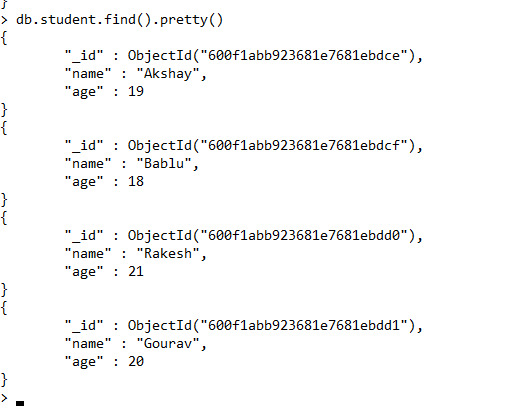sort()方法指定查询从给定集合中返回匹配文档的顺序。从数据库中检索任何文档之前,必须将此方法应用于光标。它以文档作为参数,其中包含定义结果集排序顺序的field:value对。值为1或-1分别指定升序或降序。
- 如果每次我们对相同数据执行排序时,排序都返回相同的结果,则这种类型的排序称为稳定排序。
- 如果每次我们对相同数据执行排序时,排序都返回不同的结果,则这种类型的排序称为不稳定排序。
- MongoDB通常执行稳定的排序,除非对包含重复值的字段进行排序。
- 我们可以使用limit()方法和sort()方法,它将返回前m个文档,其中m是给定的限制。
- MongoDB可以使用索引找到排序操作的结果。
- 如果MongoDB没有使用索引扫描找到排序顺序,则它将使用top-k排序算法。
用法:
db.Collection_Name.sort({filed_name:1 or -1})
参数:
该参数包含一个field:value对,用于定义结果集的排序顺序。值是1或-1,分别指定升序或降序。参数的类型是文档。
返回:
它按排序顺序返回文档。
例子:
在以下示例中,我们正在使用:
Database: gfg
Collections: student
Document: Four documents contains name and age of the students.

- 按年龄升序返回所有文档:
db.student.find().sort({age:1})

- 按年龄降序返回所有文档:
db.student.find().sort({age:-1})

- 按照年龄的升序返回所有文档:
db.student.find().sort({name:1})

- 按年龄降序返回所有文档:
db.student.find().sort({name:-1})

相关用法
- MongoDB Update()用法及代码示例
- MongoDB skip()用法及代码示例
- MongoDB limit()用法及代码示例
- MongoDB FindAndModify()用法及代码示例
- MongoDB FindOne()用法及代码示例
- MongoDB countDocuments()用法及代码示例
- MongoDB getIndexes()用法及代码示例
- MongoDB Distinct()用法及代码示例
- MongoDB dropIndex()用法及代码示例
- MongoDB findOneAndDelete()用法及代码示例
注:本文由纯净天空筛选整理自sachinchhipa44大神的英文原创作品 MongoDB – sort() Method。非经特殊声明,原始代码版权归原作者所有,本译文未经允许或授权,请勿转载或复制。
